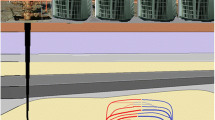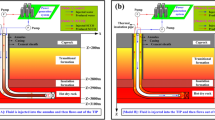Abstract
In this research, a simulation was performed for evaluating power production from an abandoned geothermal well as an enhanced geothermal system by injecting a secondary fluid. Abandoned wells, due to lack of fluid or very low transmissivity, are regarded among the low-to moderate-temperature resources that have the potential for heat production without any cost for deep drilling. Accordingly, they are taken as suitable sources of energy. In the present paper, an abandoned geothermal well at Meshkinshahr geothermal field in Sabalan district, northwestern Iran, with 3176 m depth was simulated. The bottom-hole temperature of 148 °C, as well as well casing size, and real thermal gradient for well were applied in the model. A 3D heat transfer simulation model was designed by considering a coaxial pipe as a down-hole heat exchanger between surrounding rocks of the well and injected fluid. Injected fluid to the well with specified pressure and temperature receives heat from rocks surrounding the well, until it reaches the bottom of the well and converts to vapor. The vapor returns to the surface from inner pipe with very low heat loss during its return. The inner pipe is isolated by a thin layer having a low heat conductivity to prevent heat loss from the returned fluid. It was observed that obtained heat in the well depends on temperature profile of the well, injection velocity, and fluid mass flow rate. The model results were optimized by selecting suitable parameters such as inlet injection speed and fluid flow rate to achieve the highest temperature of the fluid returned from the well. A binary power plant was also modeled to determine the extractable power using returned fluid as input using ammonia and isobutene, as working fluids in binary cycle. Finally, electric power of 270 kW was generated from well NWS3 using designed down-hole heat exchanger.












Similar content being viewed by others
References
ANSYS FLUENT Tutorial Guide. (2011) ANSYS, Inc. November.
Asaad, Y. (1955). A study of the thermal conductivity of fluid-bearing porous rocks. (PhD thesis, University of California, Berkeley).
Baker, H. (2012). Baker Hughes investor relations [Online]. http://gis.bakerhughesdirect.com/RigCounts. Accessed January 2013.
Barbier, E. (2002). Geothermal energy technology and current status: an overview. Renewable and Sustainable Energy Reviews, 6, 3–65.
Bertani, R. (2012). Geothermal power generation in the World 2005–2010 update report. Geothermics, 41, 1–29.
Bu, X., Ma, W., & Li, H. (2012). Geothermal energy production utilizing abandoned oil and gas wells. Renewable Energy, 41, 80–85.
Cheng, W. L., Li, T. T., Nian, Y. L., & Wang, C. L. (2013). Studies on geothermal power generation using abandoned oil wells. Energy, 59, 248–254.
Combs, S. (2008). Chapter 21—Geothermal. Retrieved January 2013, from Window on State Government: http://www.window.state.tx.us/specialrpt/energy/renewable/geo.php.
Davis, A. P., & Michaelides, E. E. (2009). Geothermal power production from abandoned oil wells. Energy, 34, 866–872.
Ebrahimi, M., & Torshizi, S. E. M. (2012). Optimization of power generation from a set of low-temperature abandoned gas wells, using organic Rankine cycle. Journal of Renewable Sustainable Energy, 4, 063133.
Emirov, S. N., & Ramazanova, E. N. (2007). Thermal conductivity of sandstone at high pressure and temperature. High Temperature, 45, 317–320.
Feng, X., Xu, J., Wang, M. N., & Yu, L. J. (2010). The advantage of the organic Rankine cycle system in the low-temperature heat recovery. Energy Conservation Technology, 28, 387–391.
Gallup, D. L. (2009). Production engineering in geothermal technology: a review. Geothermics, 38, 326–334.
Gupta, H., & Roy, S. (2007). Geothermal energy an alternative resource for the 21st century (p. 11). Amsterdam: Elsevier.
Guzovic, Z., Majcen, B., & Cvetkovic, S. (2012). Possibilities of electricity generation in the Republic of Croatia from medium-temperature geothermal sources. Applied Energy, 98, 404–414.
Hellström, G. (1998). Thermal performance of borehole heat exchangers. In Second Stockton International Geothermal Conference, Stockholm, Sweden; March 16–17.
Hellström, G. (2002). Borehole heat exchangers: state of the art 2001. In R. Hummelshöj, J. Hansen, & K. Lorenzen (Eds.), Implementing agreement on energy conservation through energy storage: annex 13—design, construction and maintenance of UTES wells and boreholes. Subtask 2. International Energy Agency (IEA).
Hettiarachchi, H. D. M., Golubovic, M., Worek, W. M., & Ikegami, Y. (2007). Optimum design criteria for an organic Rankine cycle using low-temperature geothermal heat sources. Energy, 32, 1698–1706.
Incropera, F. P., De Witt, D. P., Bergman, T. L., & Lavine, A. S. (2007). Fundamentals of heat and mass transfer (6th ed.). Hoboken: Wiley.
Kotler, S. (2011). Abandoned oil and gas wells are leaking. http://www.zcommunications.org/abandoned-oil-and-gas-wells-are-leaking-bysteven-kotler. Accessed Jan 2013.
Kujawa, T., Nowak, W., & Stachel, A. A. (2006). Utilization of existing deep geological wells for acquisitions of geothermal energy. Energy, 31, 650–664.
Kuo, G. (2012). Geothermal energy. Bethesda, MD: World Future Society.
Majorowicz, J., & Grasby, S. E. (2014). Geothermal energy for Northern Canada: is it economical? Natural Resources Research, 23, 159–173.
Michaelides, E. E. (2012). Alternative energy sources. Berlin: Springer.
Moghaddam, M. K., Noorollahi, Y., Samadzadegan F., Sharifi M. A., & Itoi R. (2013). Spatial data analysis for exploration of regional scale geothermal resources. Journal of Volcanology and Geothermal Research, 266, 69–83.
Moghaddam, M. K., Samadzadegan, F., Noorollahi, Y., Sharifi, M. A., & Itoi, R. (2014). Spatial analysis and multi-criteria decision making for regional-scale geothermal favorability map. Geothermics, 50, 189–201.
Nellis, G., & Klein, S. (2008). Heat transfer (p. 633). New York: Cambridge University Press.
Noorollahi, Y., & Itoi, R. (2011). Production capacity estimation by reservoir numerical simulation of northwest (NW) Sabalan geothermal field, Iran. Energy, 36, 4552–4569.
Noorollahi, Y., Itoi, R., Fujii, H., & Toshiaki, T. (2008). GIS integration model for geothermal exploration and well siting. Geothermics, 37, 107–131.
Pathak, V., Babadagli, T., Majorowicz, J. A., & Unsworth, M. J. (2014). Evaluation of engineered geothermal systems as a heat source for oil sands production in Northern Alberta. Natural Resources Research, 23, 247–265.
PDE Solutions Inc. (2011). FlexPDE 6. Saskatoon, SK: PDE Solutions Inc.
Procesi, M., Cantucci, M., Buttinelli, M., Armezzani, G., Quattrocchi, F., & Boschi, E. (2013). Strategic use of the underground in an energy mix plan: synergies among CO2, CH4 geological storage and geothermal energy. Latium Region case study (Central Italy). Applied Energy, 110, 104–131.
Roy, J. P., Mishra, M. K., & Misra, A. (2011). Performance analysis of an organic Rankine cycle with superheating under different heat source temperature conditions. Applied Energy, 88, 2995–3004.
Saleh, B., Koglbauer, G., Wendland, M., & Fischer, J. (2007). Working fluids for low temperature organic Rankine cycles. Energy, 32, 1210–1221.
SKM, (2004). Report on completion tests and heat up surveys for well NWS1. Sinclair Knight Merz (SKM) and Renewable Energy Organization of Iran.
SKM, (2004). Well NWS3 drilling completion report, Sinclair Knight Merz (SKM) and Renewable Energy Organization of Iran.
SKM, (2004). Well NWS4 drilling completion report, Sinclair Knight Merz (SKM) and Renewable Energy Organization of Iran.
Tempesti, D., Manfrida, G., & Fiaschi, D. (2012). Thermodynamic analysis of two micro CHP systems operating with geothermal and solar energy. Applied Energy, 97, 609–617.
Templeton, J. D., Ghoreishi-Madiseh, S. A., Hassani, F., & Al-Khawaja, M. J. (2014). Abandoned petroleum wells as sustainable sources of geothermal energy. Energy, 70, 366–373.
Wei, D., Lu, X., Lu, Z., & Gu, J. (2007). Performance analysis and optimization of organic Rankine cycle (ORC) for waste heat recovery. Energy Conversion and Management, 48, 1113–1119.
Wohletz, K., & Heiken, G. (1992). Volcanology and geothermal energy. Berkeley: University of California Press.
Yamamoto, T., Furuhata, T., Arai, N., & Mori, K. (2001). Design and testing of the organic Rankine cycle. Energy, 26, 239–251.
Yavuzturk, C., & Chiasson, A. D. (2002). Performance analysis of U-tube, concentric tube, and standing column well ground heat exchangers using a system simulation approach. ASHRAE Transactions, 108, 925–938.
Yeoh, G. H., & Yuen, K. K. (2009). Computational fluid dynamics in fire engineering: theory, modelling and practice. Burlington, MA: Elsevier.
Yousefi, H., Noorollahi, Y., Ehara, S., Itoi, R., Yousefi, A., & Fujimitsua, Y. (2010). Developing the geothermal resources map of Iran. Geothermics, 39, 140–151.
Zhang, S., Wang, H., & Guo, T. (2011). Performance comparison and parametric optimization of subcritical organic Rankine cycle (ORC) and transcritical power cycle system for low temperature geothermal power generation. Applied Energy, 88, 2740–2754.
Acknowledgment
The authors are grateful to the Energy Resources Engineering Laboratory of Kyushu University for funding the research program of the first author through which the current study was conducted. Many thanks for the anonymous reviewers of the paper and special thanks for the editor-in-chief, Dr. John Carranza, for their valuable comments which helped improve the earlier versions of this paper.
Author information
Authors and Affiliations
Corresponding author
Rights and permissions
About this article
Cite this article
Noorollahi, Y., Mohammadzadeh Bina, S. & Yousefi, H. Simulation of Power Production from Dry Geothermal Well Using Down-hole Heat Exchanger in Sabalan Field, Northwest Iran. Nat Resour Res 25, 227–239 (2016). https://doi.org/10.1007/s11053-015-9270-3
Received:
Accepted:
Published:
Issue Date:
DOI: https://doi.org/10.1007/s11053-015-9270-3




